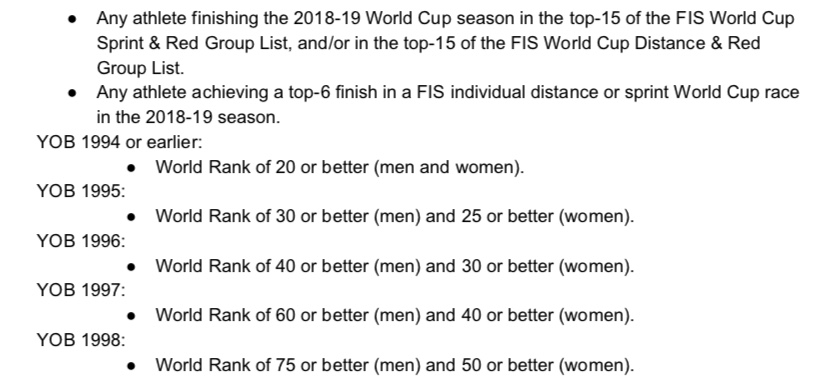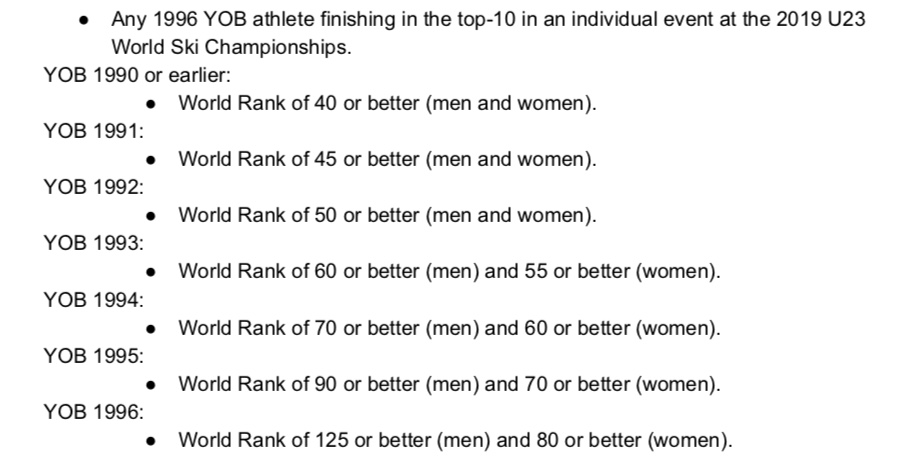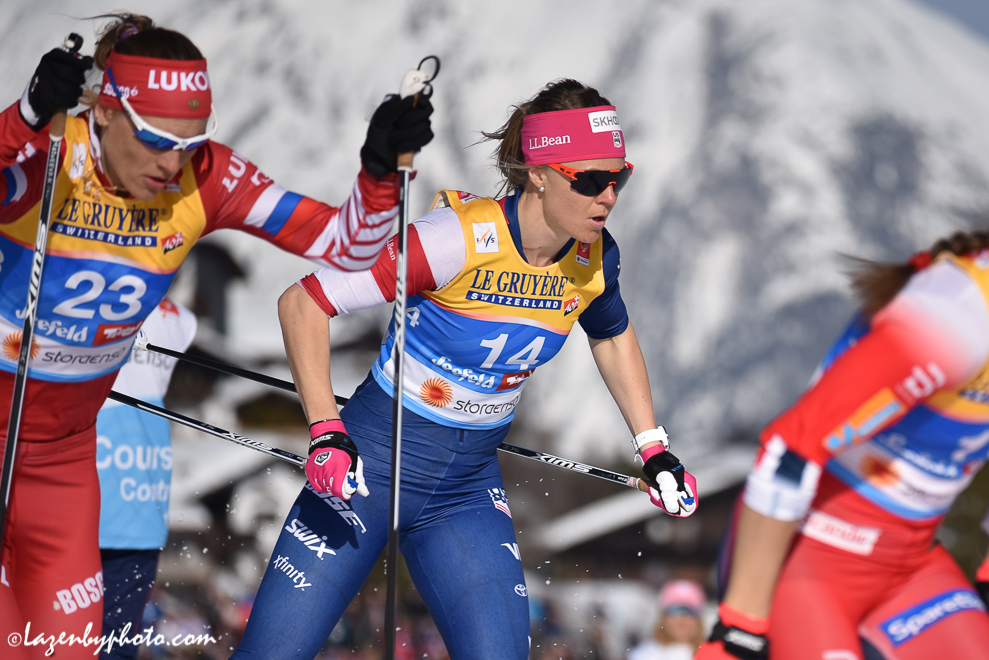
On May 6, U.S. Ski & Snowboard sent out a press release announcing the 2019-2020 U.S. Cross-Country Ski Team (USST). Twenty athletes were named to the team comprised of A, B, and D-Team selections. One of the most notable aspects of this year’s iteration of the USST is that all 20 skiers were nominated by meeting objective criteria. No athletes were discretioned despite the published criteria including language for discretionary picks and no specific limitation on team size.
This past year the USST implemented criteria guidelines based on an athlete’s year of birth (YOB) and a minimum World Rank on the 8th FIS points list. (An athlete’s best World Rank between sprint or distance was considered.) The criteria also included non-age weighted performance benchmarks that auto-qualified athletes for an A-Team nomination.
“The great thing is, from our perspective, we feel very pleased with how the selection criteria is working so far,” USST Head Coach Chris Grover said in a call on April 29. “It has selected 20 athletes objectively, and it is selecting a lot of the younger athletes which I think is reflective of the fact that we have a massive amount of talent in our junior and our U23 groups. It seems like so far, in its first year, it seems like it is grabbing the right athletes. The tough thing about it or any other criteria is that there are a lot of great athletes that are just on the outside of making it too. I don’t want to take anything away from all those athletes who fell just outside the criteria because there were some absolute standout performances in that group. But that said, objective criteria tend to draw a line and you can find yourself as an athlete easily on one side of the line of the other.”
A-Team
Beginning with the A-Team, Simi Hamilton, Erik Bjornsen, Sadie Bjornsen, Rosie Brennan, Sophie Caldwell, and Jessie Diggins made the cut by meeting at least one portion of the A-Team criteria listed below.
Hamilton met the standard by placing top-six in a World Cup individual race with his fourth place in Cogne, Italy’s freestyle sprint and earning a “Winner of the Day” fourth place in Québec’s 15 k skate pursuit. Erik Bjornsen advanced to the A-Team by skiing to a third place “Winner of the Day” time in Lillehammer, Norway’s 15 k classic pursuit. (We’ll explore this towards the end of this piece, however, the recently published draft 2020-2021 USST nomination criteria has been modified to exclude “Winner of the Day” results when considering a top-six on the World Cup.)
Diggins and Bjornsen ranked within the top-15 in the final sprint and distance World Cup rankings. Caldwell was ranked fourth overall in the sprint standings. Those respective benchmarks met the auto-qualification standards of a top-15 World Cup rank in either sprint or distance to be an A-teamer. Rosie Brennan — along with Diggins, Bjornsen, and Caldwell — jumped the top-six placing on the World Cup hurdle. Brennan earned a World Cup career-best sixth place in the Davos, Switzerland 10 k skate.
B-Team
Kevin Bolger and Scott Patterson are the returnees. Julia Kern and Hailey Swirbul bumped up from the D-Team. Caitlin Patterson sits as the only newly minted B-Team athlete who is new to the USST.
The B-Team nominations rely on YOB / World Rank standards or a performance standard of a top-10 individual result at U23 Worlds for an athlete born in 1996 or later. (Below are the B-Team criteria.)
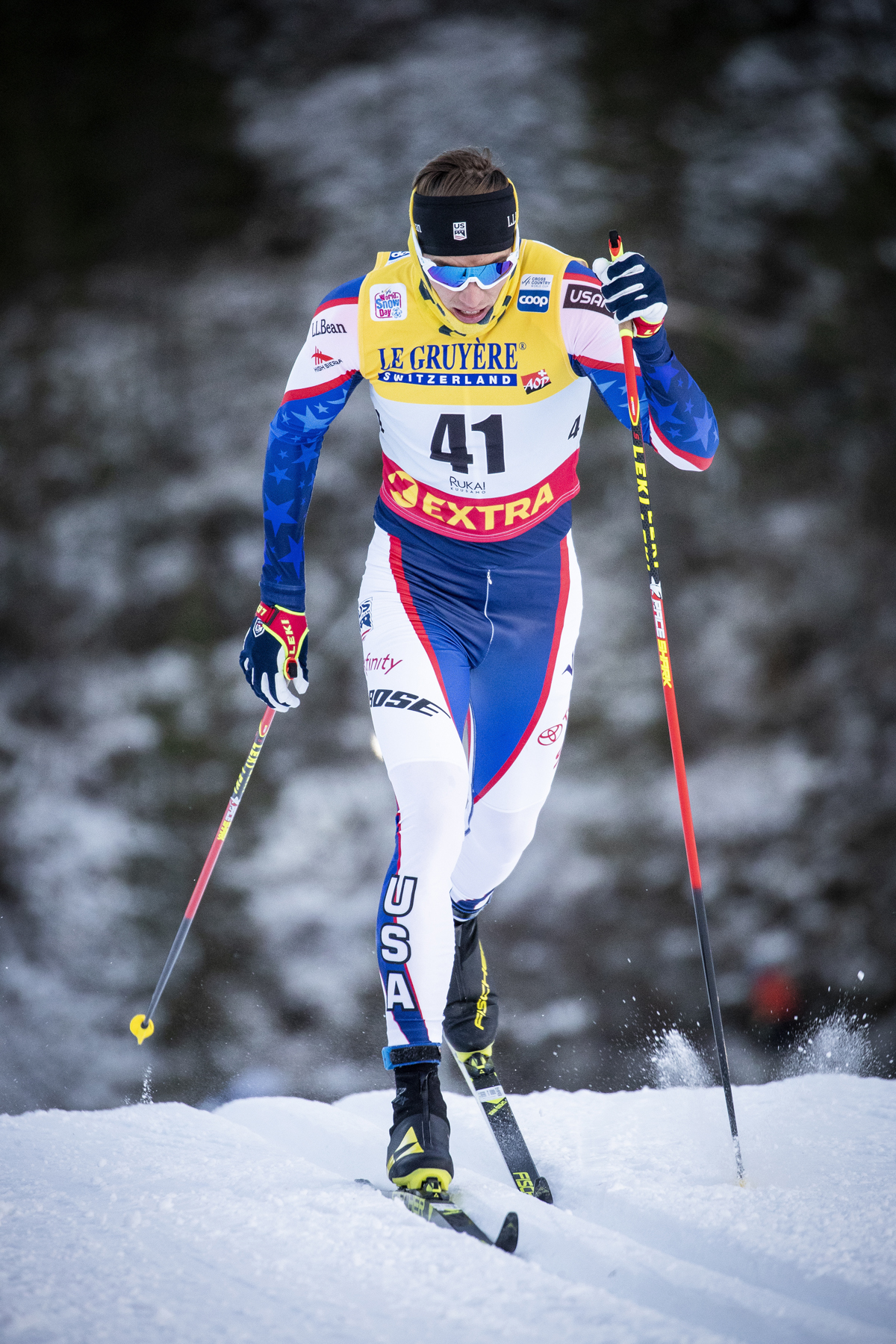
Born in 1998, making her twenty-years-old, Swirbul placed 10th in the U23 15 k mass start classic. She also ranked 58th in distance on the final (8th) FIS Point / World Ranking list.
Kern, at twenty one years old, YOB 1997, held a sprint World Rank of 57th on the 8th points list to make the B-Team.
Caitlin Patterson, born in 1990, ranked 32nd in distance on the 8th FIS points list to meet the standard.
Younger brother Scott Patterson (YOB 1992), ranked 47th in distance on the 8th FIS points list.
Bolger (YOB 1993), ranked as the 38th sprinter on the 8th FIS points list.
With the new strict constructionist standards, missing the objective criteria can become a function of aging out on a team nomination by not meeting a specific age-related World Rank by the time the 8th FIS Points list is published. Here’s Grover with his thoughts on that process.
“Of course the older you are as an athlete, the tougher the World Rank that you need to be able to achieve to stay on that pathway. Interestingly, you have an athlete like Andy Newell, an absolute veteran, only three places outside of the criteria for the B-Team. On the women’s side, Kelsey Phinney, three places outside the criteria. Back on the men’s side: Adam Martin five places outside. Logan Hanneman, eight places out. Kyle Bratrud, ten places out. David Norris 12 places out. That is a handful of athletes, all of whom had some absolute standout performances, who are just outside the criteria. And this is, I think, this is where having this new criterion and having it be completely as objective as possible is really going to be meaningful for the community. In the past, there would have been a lot of very tough discretion cases with all of those athletes that I just mentioned. Athletes and clubs and coaches and parents would have had a very hard time understanding necessarily why so and so was picked and why so and so wasn’t picked via discretion because it’s really hard for us to compare athletes at different ages against similar performances. And so I think the new criteria, although it draws a hard line, it is going to in the long run take away some of the mystery of selection and hopefully prevent a little bit of the heartache that goes along with that.”
D-Team
The D-Team remains robust. And promising. By design, it is a true U23 squad: an athlete must categorically be under the age of 23 to qualify. (See D-Team criteria below.)
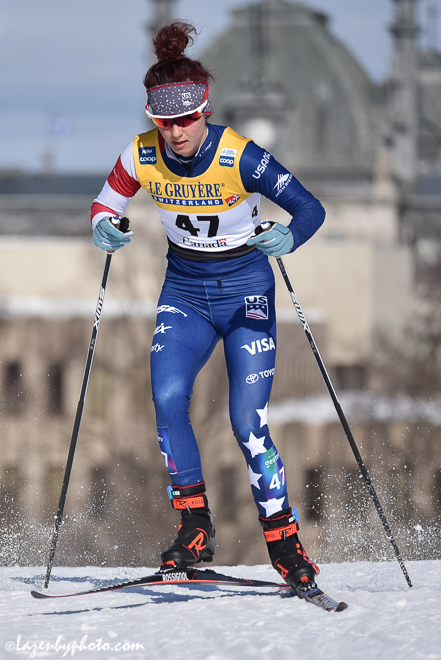
New to the men’s side are Johnny Hagenbuch, Luke Jager, Noel Keeffe, and Zak Ketterson. Ben Ogden and Gus Schumacher are returnees. For the women, Hannah Halvorsen also returns. Novie McCabe and Kendall Kramer are the new women’s additions.
The following skiers all placed well enough (a top-10) in individual events at World Juniors to meet the D-Team top-10 performance standard. Schumacher auto-qualified by placing sixth in the World Junior’s 10 k skate and fourth in the 30 k mass start classic. Ogden was 10th in the 30 k and eighth in the classic sprint. In the 15 k classic mass start, Kramer skied to fourth, McCabe 10th.
Hagenbuch, Jager, Keefe, and Ketterson met the YOB / World Rank criteria for their respective D-Team nominations as did Halvorsen.
The lone outlier here initially was Ketterson. The 8th FIS points list had Ketterson listed at 177th in the distance rankings. Ketterson’s YOB is 1997, meaning he fell two places short of the minimum World Rank of 175.
On that final list preventing Ketterson from auto-qualifying were several skiers arrested for doping activity in Seefeld, Austria during the 2019 World Championships. Those athletes were Austria’s Dominik Baldauf and Maz Hauke, and Kazakhstan’s Alexey Poltoranin.
(Baldauf ranked 119 on the 8th distance list, Hauke 83rd, and Poltoranin 31st.)
“Zak pointed out to us something we hadn’t actually dug into and actually taken a look at,” Grover said. “That perhaps three of the athletes who were busted in Seefeld were still on the list — the World Ranking list — still with their active FIS licenses ahead of him. And so our perspective was that those athletes should not be ranked ahead of him. And we weren’t going to let doping basically prevent an athlete from being nominated to the team. That is the one person who I guess technically could be looked at as outside of it. We felt strongly that those athletes should not count against somebody’s World Rank.”
Reflection and World Cup Starts:
“Because it is a new criteria it is a change for the community and I think some very understandable frustration on a part of the few athletes who were just outside of making the criteria because several years ago the result that they just had might have been good enough for a discretionary nod to be nominated to the ski team,” Grover said. “I absolutely understand that and understand that frustration and that disappointment with brand new criteria. It is a change for the community. It takes a little while for everybody to come to a point where they feel like they can understand it fully and also have that expectation in mind. That is a challenge. But I think it is a real step in the right direction.”
With the objective nomination standards defined, Grover noted a working group had already made changes to a draft of next season’s 2021 USST nomination criteria. That draft is posted on the U.S. Ski & Snowboard website. The initial changes, so far, have been isolated to the A-Team criteria. The change specifically addresses the issue of whether or not the criteria will recognize “Winner of the Day” as part of a top-six (or top-12) individual World Cup performance.
“Last year we did not specify in that language, mistakenly did not specify in that language, that we were not looking for a ‘Winner of the Day’ performance, but we’re looking for an individual result page performance. So we specified that in the criteria,” Grover said. “The intention is to focus on events we can medal in … we are trying to capture World Cup performances that are on the pathway to obtaining a medal and obviously there are no medals for the ‘Winner of the Day’ performances.”
Additionally, next year, a top-six in an individual sprint or distance World Cup race alone will not pass muster for an A-Team nomination. An athlete will also need to post a top-12 in an individual World Cup event. The language in the current draft states these results will be “excluding ‘Winner of the Day’ performances in Pursuit events.”
The path to the World Cup does not rely solely on USST membership. Open spots remain available for Period 1. According to Grover, Diggins, Sadie and Erik Bjornsen, Brennan, Hamilton, Caldwell, and the two Continental Cup leaders (Kern and Kyle Bratrud) have secured Period 1 starts. Otherwise, a 15 member working group will determine who will fill any remaining Period 1 starts using discretion.
“My intention is actually to meet face to face with that group hopefully at U.S. Ski & Snowboard congress here in May, make the selections and then notify athletes,” Grover explained. “We are in May basically, so they have the summer and the fall to prepare for coming over to World Cup.”
Absent from this year’s USST are several notable athletes. Former D-Team skier Katharine Ogden continues to have a stellar collegiate career. She will be a third-year student at Dartmouth next season. Ian Torchia aged out from the D-Team as he recently turned 23. And Patrick Caldwell, a B-Team athlete last season, announced recently he has retired from elite level competition to begin a job in renewable energy based in Denver, Colo.
Jason Albert
Jason lives in Bend, Ore., and can often be seen chasing his two boys around town. He’s a self-proclaimed audio geek. That all started back in the early 1990s when he convinced a naive public radio editor he should report a story from Alaska’s, Ruth Gorge. Now, Jason’s common companion is his field-recording gear.

